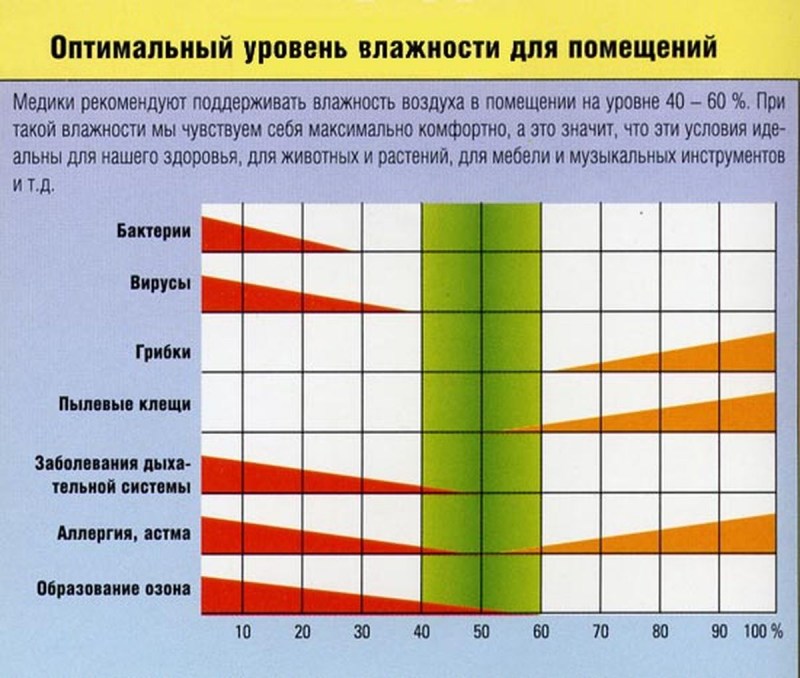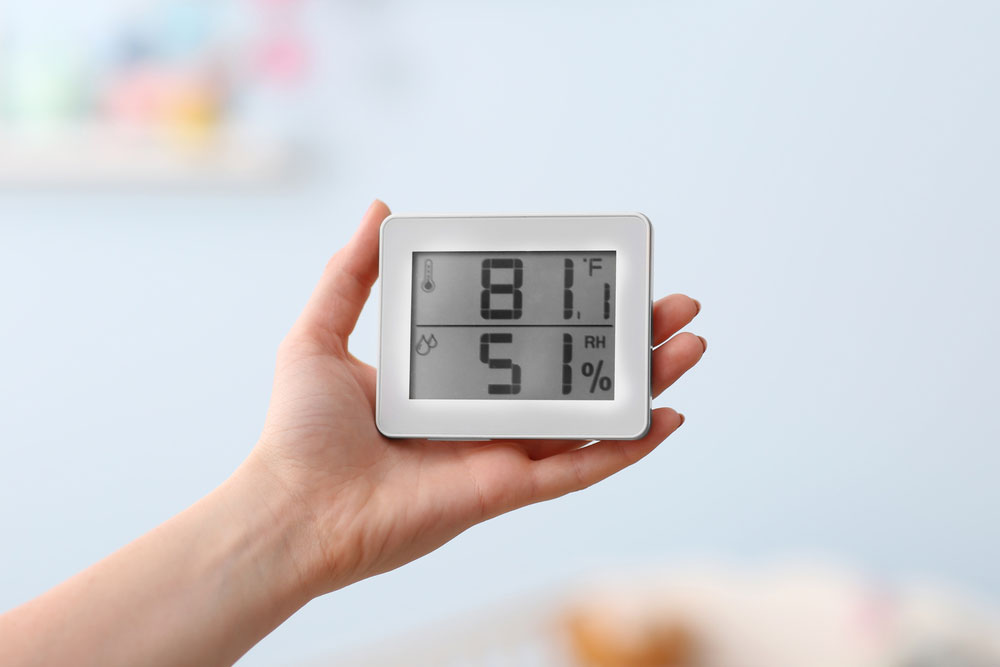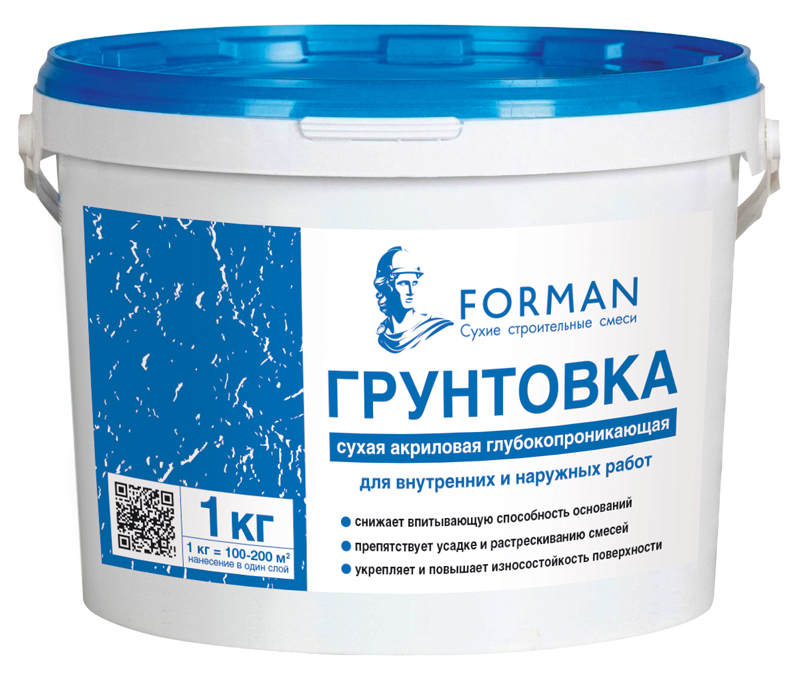The degree of saturation of air with moisture affects the state of human health. If the level is insufficient, breathing is difficult, and if the indicators are significantly higher than the humidity level in the house for a person, fungus and mold will form on the walls. Breathing such air is very dangerous. How to measure the humidity in the room? Which hygrometer to choose? How to lower or increase the humidity level if necessary? How to choose a humidifier or dehumidifier for an apartment?
Humidity rates in rooms
What humidity should be in the house? According to construction standards in accordance with GOST, the optimum humidity in the rooms in the cold season is 30-35%, in the warm - 30-60%. In winter, the maximum humidity level should not exceed 60%, in summer - 65%. It is proposed that these standards be oriented not to apartment residents, but to those who design, build and maintain residential buildings and commercial premises. Doctors recommend keeping the humidity level at 40-60% at any time of the year.

The maximum humidity level in an apartment is usually in the kitchen and in the bathroom. Water procedures and cooking significantly increase the temperature and concentration of water in the air. Good ventilation will solve the problem, but in apartments of standard buildings this is not always ensured to the maximum. Therefore, in addition, you need to install a powerful exhaust hood and often ventilate the room. In the living room and bedroom, the optimum humidity is 40-55%, in the home office - 30-40%. Higher rates can adversely affect documents, appliances and furniture.
Humidity standards for children's rooms
What humidity should be in the house where there is a child? It is more difficult for a child’s body to cope with negative environmental factors than an adult. Children catch colds easily, suffer diseases harder, more often catch viruses and infections, freeze faster and overheat. The microclimate should maximize the support of the body's defenses. In this case, it is very important to observe the humidity standards in a residential building.
With low humidity, the mucous membranes dry out and lose their ability to effectively resist infections, the skin may begin to peel off. Normal humidity in the house where there is a child is 50-60%. Well-known pediatrician Dr. Komarovsky insists on higher rates - 60% for a healthy child and 70% for a child who is sick. It is recommended to maintain the temperature in the nursery not higher than 24 degrees, optimally - 20-22 degrees.
How to measure the humidity in the apartment?
How to determine air humidity? The easiest and most reliable way is to use a special device called a hygrometer. If it is not available, it is possible to determine whether the humidity in the house meets the norm, using the means available at home, but the accuracy in this case is significantly reduced. In addition, the result is not certain digital data: using home methods you can only determine if the air in the apartment needs additional humidification or not.
Which hygrometer to choose for the house?
How to measure the humidity in the apartment? The easiest way to do this is with a hygrometer. There are several types of such instruments for measuring the humidity level in a room: electronic, condensation (receive information from a special mirror on which condensate forms under certain conditions), weight (measure the amount of water vapor), psychrometric (determine the difference between the readings of two thermometers) and hair (the work is based on the natural property of human hair to slightly change the length under the influence of moisture). Depending on the type of hygrometer, the principle of action is different.
The most accurate and convenient is an electronic device, which, if necessary, can be moved from one room to another or installed permanently. Choosing a hygrometer, you need to focus on accuracy - the deviation in measurements should ideally not exceed 1%. Many models are equipped with additional functions: measuring room temperature and atmospheric pressure, displaying the current date and time, the ability to set an alarm or timer. Some hygrometers inform about violations in the microclimate by light indicators, which allows you to notice the problem in a timely manner.
Five Accurate Hygrometer Models
How to determine the humidity in the room? To do this, it is enough to install a hygrometer and observe the readings. Judging by the reviews, the best choice is the Stadler Form S-003. The device runs on a single battery, due to which it was possible to achieve a thickness of the apparatus of only four millimeters. The device for measuring humidity in the room has a stylish design, sold in several colors. The battery lasts for a long time. The hygrometer measures humidity and temperature; it is distinguished by accuracy of indicators. The only drawback is that the glossy LCD displays when exposed to sunlight.
Ramili Baby ET1003 is suitable for a children's room with an interesting design and animated images on the screen. If the indicators are normal, a smiley will appear on the display, with slight deviations the character will not express any emotions, and if the microclimate worsens, she will be upset and stop smiling. Data is displayed in digital format. The error is ± 5%. Power - One AAA battery (not included). The device does not have a good level of energy saving, so the batteries will have to be changed often.
A very compact (only 4 cm x 4 cm x 1 cm) mechanical instrument for measuring indoor air humidity is the Boneco A7057. It works without battery. On the front panel there is a scale of indicators with a range from twenty percent to one hundred, the price of one division is 1%. This is a high precision hygrometer with minimal error. Install the device so that there are no heating appliances or air conditioning systems nearby. For convenient fixing on the wall, a special Velcro is provided on the rear panel. Before use, the manufacturer recommends calibrating the device by comparing the indicators with another mechanical hygrometer and (if necessary) adjusting it with the adjusting screw.

A complete home weather station at an affordable cost is the KetotekHTC-2. A digital hygrometer measures not only air humidity (from 0% to 100%) in a room, but also temperature. It can be used indoors and outdoors because it is adapted to Russian meteorological conditions: the temperature measurement range, for example, is -50 ... 70 degrees Celsius, and for a room - 10 ... 50 degrees. A lot of data is displayed on the LCD screen at once, the font is large, easy to read from a distance. The model has an alarm option. Management is carried out using three buttons (mechanical).
Measuring humidity with a glass
How to measure the air humidity in an apartment using an ordinary glass of water? You need to fill in a glass of cold water and place it in the refrigerator for several hours. The temperature of the water in the tank should be 3-5 degrees Celsius. A chilled glass should be placed indoors, but not near heating appliances or air conditioning systems, and observed.
If the outer surface of the walls of the glass became condensed almost immediately, but dried up after ten minutes, then the air is very dry. If condensate droplets formed on the walls in ten minutes, flowing down the walls of the glass, then the humidity is very high. If in ten minutes the surface has not dried out, but has not been covered with large drops, then the air is of medium humidity.
Asman Psychrometric Table
How to determine if the humidity in the house is in compliance with the norm? Another measurement method copies the principle of operation of another device - a psychrometer. First you need to measure the temperature in the room using a conventional mercury thermometer. Then the head of the measuring device must be wrapped with wet gauze for 10 minutes and once again determine the temperature. Subtract the second result from the first value. Indicators can be estimated on the Asman table. The approximate humidity level is at the intersection of the “dry” thermometer and the difference in measurements.
Danger of too dry air
The problem of air dryness is more relevant in the winter season. The air in the living rooms is dried by central heating radiators, the lack of regular ventilation, low temperature. In summer, the main cause of dry air is the use of air conditioning. If the humidity in the house is below normal, then the mucous membranes dry out, lips crack, throat persists, a light cough may begin, the skin of the face and hands is dry and flaky, cracks in the hands may appear, synthetic hair and clothing are electrified, the tips of the leaves dry out of indoor plants .
Too dry air is not a dangerous phenomenon, but an unpleasant one. Human mucous membranes secrete a special secret that protects against seasonal infections from entering the body. When dry, this barrier becomes thinner and damaged. Constant irritation of the upper respiratory tract leads to the development and exacerbation of various diseases, for example, bronchial asthma, pharyngitis or bronchitis. This is especially true in families where there are small children.
How to increase air humidity ?
If the humidity in the house is below normal, you need to increase the indicators to optimal. Mechanical (traditional), steam or ultrasonic humidifiers perfectly cope with this task. There are other ways to increase humidity in a living room:
- regularly do wet cleaning (in the process, dust is also removed, which can cause an allergic reaction);
- minimize the use of heating appliances and air conditioning;
- buy an aquarium (the only drawback is that you need special knowledge to properly take care of the fish);
- install a desktop fountain with circulating clean water;
- from time to time saturate the air with moisture using a conventional spray gun;
- place wet towels on radiators (one of the safest and most convenient options);
- plant as many indoor plants as possible, especially with large leaves (the best natural moisturizers are hibiscus, indoor lemons, monstera, cyperus, scindapsus, dieffenbachia);
- place containers with water near heating appliances.
In a very short time, a boiling kettle moistens the air well. But this method provides hydration for a short time, requires constant monitoring and may be unsafe for families with children.
How to choose a humidifier?
A special device, a humidifier, will help maintain humidity standards in a private house in winter without problems. A traditional similar appliance with an air purification function can increase humidity by up to 60%. Such a device is safe for children, economical in energy consumption, is easy to use, almost silently and relatively inexpensive. The humidifier works on the principle of irrigation with cold steam. The device is recommended to be placed near heat sources or places of active air circulation.
A steam humidifier evaporates up to 700 ml of liquid per hour and increases humidity by more than 60%. The device quickly humidifies the air, sterilizes steam, can be used for inhalation and aromatherapy, automatically turns off when the water level is low. It is better not to use steam humidifiers without control devices - hygrometers or hydrostats that regulate humidity. The devices are very energy intensive (consume 200-600 watts). Some models are not equipped with a security system, so if handled improperly, they may be unsafe for children and pets.
Ultrasonic humidifiers quickly moisturize, consume little energy (40 watts without heating the liquid), practically do not make noise, but are quite expensive. Some models have remote control, provide humidification control due to the built-in hygrostat, block switching on at a low water level, can work on a timer, regulate the evaporation rate and so on. For the operation of ultrasonic devices, distilled water or filter cartridges are used, which must be changed every 2-3 months.
High humidity in the apartment
Too humid air provokes the multiplication of mold, harmful bacteria and various fungi, which is very dangerous for health. Dampness provokes the onset and severe course of acute respiratory infections, bronchial asthma and even tuberculosis. These diseases are not easy to cure in a severe form. Propagation of microbes causes an unpleasant odor, which persists even after ventilation. Heavy air makes breathing and sleep difficult, and can cause asthma attacks. In a damp room, bedding and underwear, clothes and towels are not completely dried. Bacteria actively propagating on wet tissue can cause various dermatological diseases.
Ways to reduce humidity
If the humidity level in the house is exceeded, the cause may be an external source of dampness, for example, a dilapidated roof, a damp basement, a pond located near the home. Often mold also appears on the walls in corner apartments. How to get rid of high humidity in the house? The most reliable way is to carry out repairs using waterproofing. If the reason for exceeding the humidity norm in a wooden house or city apartment is due to internal factors, then you can deal with it using air dryers or simple home methods.
To reduce humidity in the apartment, it is necessary to ensure regular ventilation, natural light and install quality hoods in non-ventilated rooms. Plastic windows in the apartment, bathroom and kitchen must be equipped with a ventilation system. The dampness is well absorbed by burning sections and working household appliances. The right microclimate helps maintain indoor plants.
Household Dehumidifiers
What humidity should be in the house? The optimal level is 40-60% or slightly higher if there is a child in the apartment. If the indicators are greatly exceeded, various health problems can occur. To prevent this, if necessary, household dehumidifiers are used, which can be stationary or mobile. The performance of the device is determined by the amount of water absorption per day in liters.
The desiccant may be adsorption or compressor. Wet air enters the compressor through the fans, and then passes through the evaporator. Moisture settles in the form of condensate, falling into a special receiver. Heated air exits through another hole in the device. The adsorption apparatus does not have moving parts, works completely silently and does not consume energy. Such a desiccant absorbs moisture using an adsorbent inside. Moisture-filled filler must be changed periodically.
Mold control
If the humidity in the house does not meet the norm (indicators are too high) for a long time, then mold may appear on the walls. The best way to combat mold is to regulate the microclimate. It is necessary to ventilate the room twice a day for at least 5-15 minutes, do not dry things on a battery, do not hang damp walls with carpets, do not put damp things in a closet, and do not close the doors of bathrooms. An antiseptic primer, bleach, ammonia, hydrogen peroxide, vinegar and baking soda will help get rid of the fungus on the walls.

Special antiseptic primers are sold in building materials stores. Bleach is not so effective, but less toxic. Sodium hypochlorite (the active substance in most bleaches) helps to get rid of most types of mold and spores, but it can ruin some surfaces. In addition, the product emits toxic fumes and corrodes the skin of the hands, so you need to work with it only in rubber gloves and with windows open. A weak acid that will destroy many common types of mold is table vinegar. For prevention, you can spray vinegar from a spray bottle onto problem areas every week.
, . , . , , . , . , , .